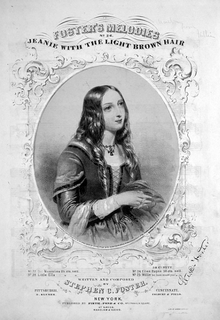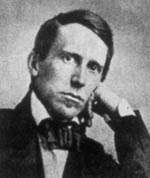Jeanie with the Light Brown Hair
| "Jeanie with the Light Brown Hair" | |
|---|---|
 Original sheet music cover | |
| Song | |
| Published | 1854 |
| Genre | Parlor song |
| Songwriter(s) | Stephen Foster |
"Jeanie with the Light Brown Hair" is a parlor song by Stephen Foster (1826–1864). It was published by Firth, Pond & Co. of New York in 1854. Foster wrote the song with his estranged wife Jane McDowell in mind. The lyrics allude to a permanent separation.[1]
"Jeanie" was a notorious beneficiary of the ASCAP boycott of 1941, a dispute caused by ASCAP increasing its licensing fees. During this period, radio broadcasters played only public domain music or songs licensed by ASCAP rival BMI. According to a 1941 article in Time magazine, "So often had BMI's Jeannie [sic] With the Light Brown Hair been played that she was widely reported to have turned grey."[2]
Background

In 1850, Stephen Foster married Jane Denny McDowell, whose nickname was "Jennie". The marriage was short-lived, however, as the pair suffered numerous conflicts and ultimately separated in 1853. Perhaps in an attempt to win back his wife, Foster composed "Jeanie With the Light Brown Hair" in 1854. The opening texts of each stanza support the speculation that the song was written with Jane in mind: "I dream of Jeanie" (verse one); "I long for Jeanie" (verse two); and "I sigh for Jeanie" (verse three).
Although the song remains one of Foster's most beloved parlor ballads, it was not commercially successful.[4] It was virtually unknown during its time and the initial ten thousand copies sold earned Foster only just over $200 in royalties. Foster, who experienced financial difficulty through most of his career, had to sell the rights to "Jeanie" (as well as other songs, including "Old Folks at Home") to make ends meet. After his death, the rights to "Jeanie With the Light Brown Hair" reverted to Jane, and then to Foster's daughter Marion in 1879.
Lyrics
| Wikisource has original text related to this article: |
I dream of Jeanie with the light brown hair,
Borne, like a vapor, on the summer air;
I see her tripping where the bright streams play,
Happy as the daisies that dance on her way.
Many were the wild notes her merry voice would pour.
Many were the blithe birds that warbled them o'er:
Oh! I dream of Jeanie with the light brown hair,
Floating, like a vapor, on the soft summer air.
I long for Jeanie with the daydawn smile,
Radiant in gladness, warm with winning guile;
I hear her melodies, like joys gone by,
Sighing round my heart o'er the fond hopes that die:—
Sighing like the night wind and sobbing like the rain,—
Wailing for the lost one that comes not again:
Oh! I long for Jeanie, and my heart bows low,
Never more to find her where the bright waters flow.
I sigh for Jeanie, but her light form strayed
Far from the fond hearts round her native glade;
Her smiles have vanished and her sweet songs flown,
Flitting like the dreams that have cheered us and gone.
Now the nodding wild flowers may wither on the shore
While her gentle fingers will cull them no more:
Oh! I sigh for Jeanie with the light brown hair,
Floating, like a vapor, on the soft summer air.
Other versions
Bing Crosby recorded the song on March 22, 1940, for Decca Records with John Scott Trotter and His Orchestra.[5]
Violinist Jascha Heifetz transcribed the song for the violin and it became a signature piece for him for years. The transcription has been performed by many subsequent violinists.
In popular culture
The opening line notably got used as the basis for the title of the TV series I Dream of Jeannie.
In the 1956 Bugs Bunny short "Broomstick Bunny", a play on the title is used in the closing lines: "Hello, air-raid headquarters? Well, you're not gonna believe this, but I just saw a genie with light brown hair chasing a flying sorceress."
A few lines of the song's first stanza are sung loudly, a cappella, in the Band of Brothers episode "Bastogne" by soldiers Joseph Liebgott, James Alley and an unnamed soldier in a foxhole, shortly before being shelled by Nazi artillery.
In the John Cassavetes motion picture Faces, an important scene occurs which revolves around the singing of this song.
The full title is used as the nickname for character Jeanie in Studio 60 on the Sunset Strip, most notably several times in the episode "The Cold Open".
One of the Pink Panther animated cartoons is entitled Genie with the Light Pink Fur; it is about a magic lamp that turns the Pink Panther into a genie.
References
- ↑ O'Connell, Joanne. "Understanding Stephen Collins Foster, His World and Music", ProQuest. March 23, 2007.
- ↑ "No Letup". Time Magazine. January 27, 1941.
- ↑ Sisario, Ben (September 20, 1998). "ON THE MAP; Stephen Foster's Old Hoboken Home". New York Times. Retrieved July 4, 2016.
- ↑ Browne, Blaine T.; Cottrell, Robert C. (2010). Lives and Times: Individuals and Issues in American History: To 1877. Rowman & Littlefield. p. 115. ISBN 978-0742561922.
- ↑ "A Bing Crosby Discography". BING magazine. International Club Crosby. Retrieved August 5, 2017.
